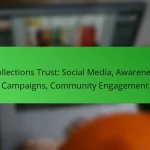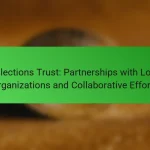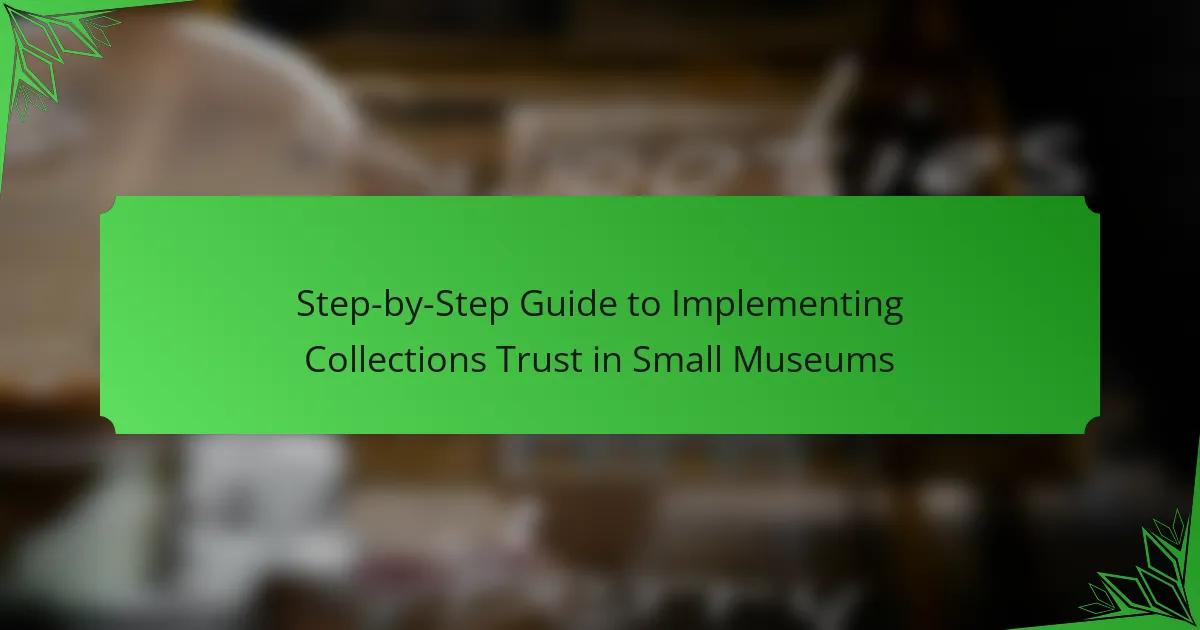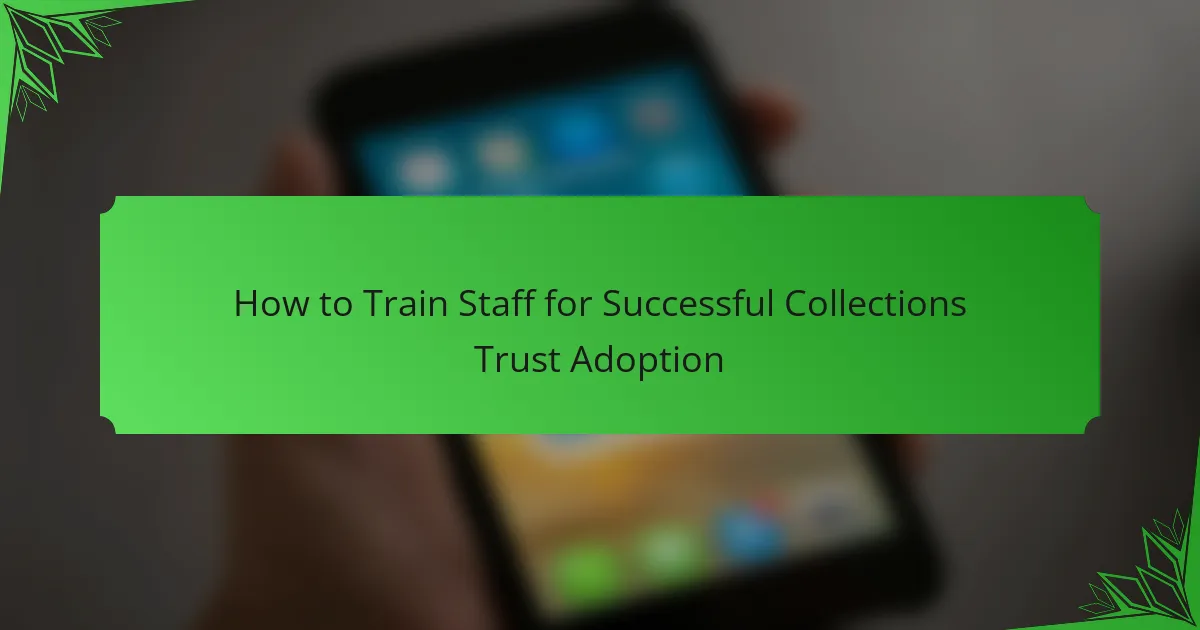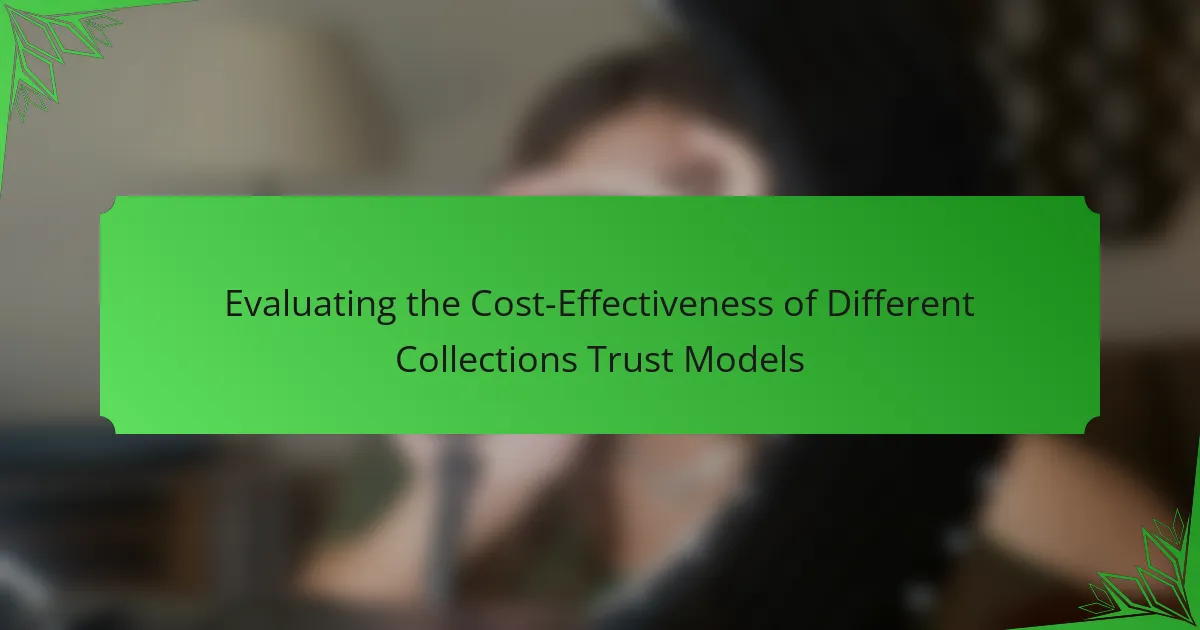Implementing Collections Trust in small museums provides a vital framework for responsible stewardship of collections, enhancing both operational efficiency and community engagement. This step-by-step guide outlines essential actions such as defining policies, engaging stakeholders, and creating a strategic plan to ensure effective management and care of collections. By following these structured steps, small museums can improve their practices and unlock new funding opportunities.
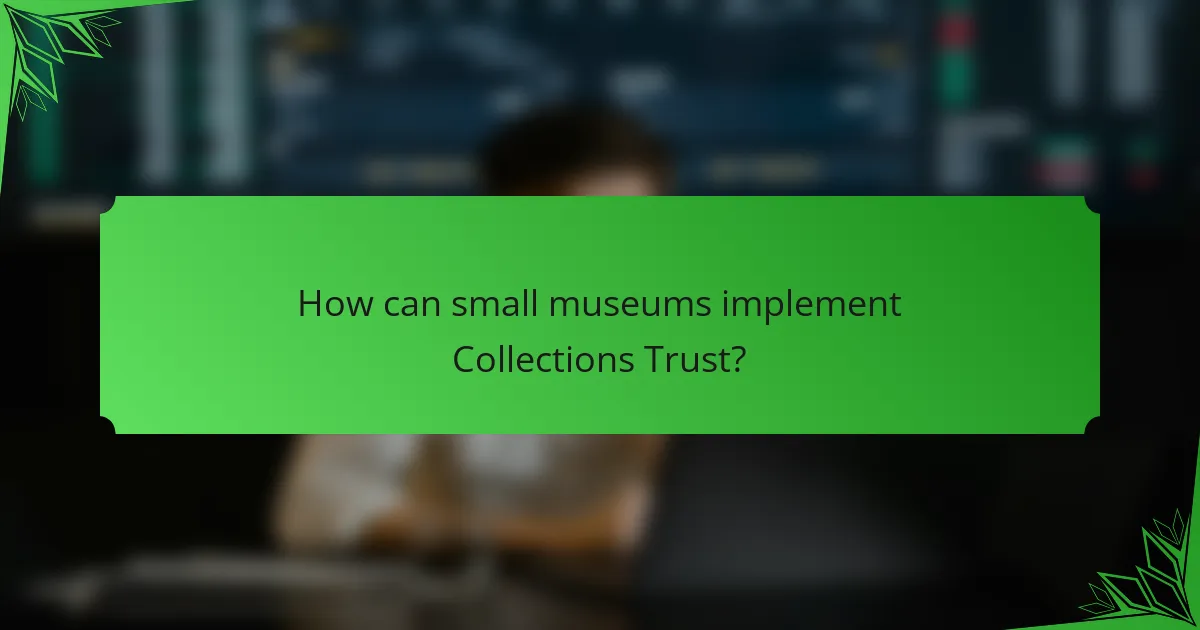
How can small museums implement Collections Trust?
Small museums can implement Collections Trust by establishing a framework that ensures responsible stewardship of their collections. This involves defining policies, engaging stakeholders, assessing current practices, creating a strategic plan, and allocating necessary resources.
Define Collections Trust framework
The Collections Trust framework provides guidelines and best practices for managing museum collections effectively. It emphasizes transparency, accountability, and sustainability in collection management. Small museums should tailor this framework to fit their specific needs and resources.
Key components of the framework include documentation standards, conservation practices, and access policies. By adopting these components, museums can enhance their operational efficiency and improve public trust.
Identify key stakeholders
Identifying key stakeholders is crucial for the successful implementation of Collections Trust. Stakeholders typically include museum staff, board members, local community representatives, and funding bodies. Engaging these groups ensures diverse perspectives and fosters collaboration.
To involve stakeholders effectively, consider organizing meetings or workshops to discuss the framework and gather input. This collaborative approach can help build a sense of ownership and commitment to the Collections Trust initiative.
Assess current collection management practices
Assessing current collection management practices involves evaluating existing policies, procedures, and technologies. Small museums should conduct a thorough review of how collections are documented, stored, and accessed. This assessment helps identify strengths and weaknesses in current practices.
Consider using a checklist to evaluate key areas such as inventory accuracy, conservation methods, and user access. This structured approach can highlight areas needing improvement and inform future planning.
Develop a strategic plan
Developing a strategic plan is essential for guiding the implementation of Collections Trust. This plan should outline specific goals, timelines, and responsibilities for stakeholders. A well-defined strategy helps ensure that all efforts align with the museum’s mission and available resources.
Include measurable objectives in the strategic plan, such as increasing public engagement or improving collection documentation. Regularly review and adjust the plan as needed to respond to changing circumstances and stakeholder feedback.
Allocate necessary resources
Allocating necessary resources is vital for the successful implementation of Collections Trust. This includes financial resources, staff time, and technological tools. Small museums should assess their budget and identify potential funding sources, such as grants or community partnerships.
Consider creating a resource allocation plan that prioritizes essential areas such as training staff, upgrading collection management software, or improving storage facilities. Effective resource management can significantly enhance the museum’s ability to implement the Collections Trust framework successfully.

What are the benefits of Collections Trust for small museums?
Collections Trust offers small museums a structured approach to managing their collections, enhancing their operational efficiency and community relevance. By implementing Collections Trust principles, these institutions can improve their collection management, engage better with their communities, and unlock new funding opportunities.
Enhanced collection management
Implementing Collections Trust helps small museums streamline their collection management processes. This includes adopting best practices for cataloging, documentation, and preservation, which can lead to improved inventory accuracy and reduced loss or damage of items.
For example, utilizing standardized cataloging systems can simplify tracking and accessing collection items. Small museums should consider investing in digital management tools that facilitate these processes, making it easier to maintain records and share information with stakeholders.
Improved community engagement
Collections Trust encourages small museums to foster stronger connections with their local communities. By involving community members in exhibitions and programming, museums can create a more inclusive environment that reflects diverse perspectives.
Small museums can host workshops, educational programs, or community events that highlight local history or culture, thus increasing visitor participation and interest. Engaging with local schools and organizations can also enhance outreach and build lasting relationships.
Increased funding opportunities
Adopting Collections Trust practices can open up new funding avenues for small museums. Grant-making bodies often look favorably on institutions that demonstrate effective collection management and community engagement, making them more competitive for funding.
Small museums should actively seek grants from local, national, and international sources that support cultural heritage and community projects. Establishing partnerships with local businesses and organizations can also provide additional financial support and resources.

What steps are involved in the Collections Trust implementation process?
The Collections Trust implementation process involves a series of structured steps to ensure effective management and care of collections in small museums. These steps include conducting stakeholder meetings, creating a collections policy, training staff on new protocols, and monitoring progress to adapt strategies as needed.
Step 1: Conduct stakeholder meetings
Begin by organizing meetings with key stakeholders, including staff, board members, and community representatives. These discussions should focus on identifying goals, expectations, and concerns regarding the collections management process.
Gathering input from diverse perspectives helps build consensus and ensures that the collections policy aligns with the museum’s mission. Aim for at least two to three meetings to cover all necessary topics thoroughly.
Step 2: Create a collections policy
Develop a comprehensive collections policy that outlines the museum’s approach to acquiring, managing, and deaccessioning items. This policy should reflect the museum’s mission and address legal and ethical considerations.
Include sections on collection care, documentation standards, and access protocols. A well-defined policy serves as a roadmap for staff and can help prevent misunderstandings or conflicts in the future.
Step 3: Train staff on new protocols
Once the collections policy is established, conduct training sessions for all staff members to ensure they understand the new protocols. This training should cover practical applications of the policy, including handling procedures and documentation practices.
Consider using hands-on workshops or online modules to accommodate different learning styles. Regular refresher courses can help maintain compliance and keep staff updated on any changes to the policy.
Step 4: Monitor and evaluate progress
Implement a system for monitoring and evaluating the effectiveness of the collections management process. This can include regular reviews of compliance with the collections policy and feedback from staff and stakeholders.
Set specific, measurable goals to assess progress, such as reducing the time taken for documentation or increasing community engagement. Adjust strategies based on evaluation results to continuously improve the collections management approach.

What challenges might small museums face with Collections Trust?
Small museums often encounter several challenges when implementing Collections Trust, including limited financial resources, resistance to change from staff, and a lack of expertise in collections management. Addressing these issues is crucial for successful integration and sustainability of collections practices.
Limited financial resources
Many small museums operate on tight budgets, making it difficult to allocate funds for implementing Collections Trust. This can hinder the ability to invest in necessary technology, training, and staffing. Prioritizing essential expenses and seeking grants or partnerships can help alleviate some financial pressures.
Consider exploring local or national funding opportunities specifically aimed at supporting museum collections. Engaging with community stakeholders may also provide additional resources or sponsorships that can ease financial constraints.
Resistance to change from staff
Staff members may resist adopting new practices associated with Collections Trust due to fear of the unknown or a preference for established routines. This resistance can slow down the implementation process and create friction within the team. Open communication about the benefits of Collections Trust can help mitigate these concerns.
Involve staff in the planning and decision-making process to foster a sense of ownership and commitment. Providing training sessions that highlight the advantages of new systems can also encourage a more positive attitude towards change.
Lack of expertise in collections management
Small museums often struggle with a lack of specialized knowledge in collections management, which is essential for effective implementation of Collections Trust. This gap can lead to improper handling of artifacts and inadequate documentation practices. Seeking external expertise or training can bridge this knowledge gap.
Consider partnering with larger institutions or professional organizations that offer workshops and resources. Online courses and webinars can also provide valuable information and skills necessary for effective collections management.
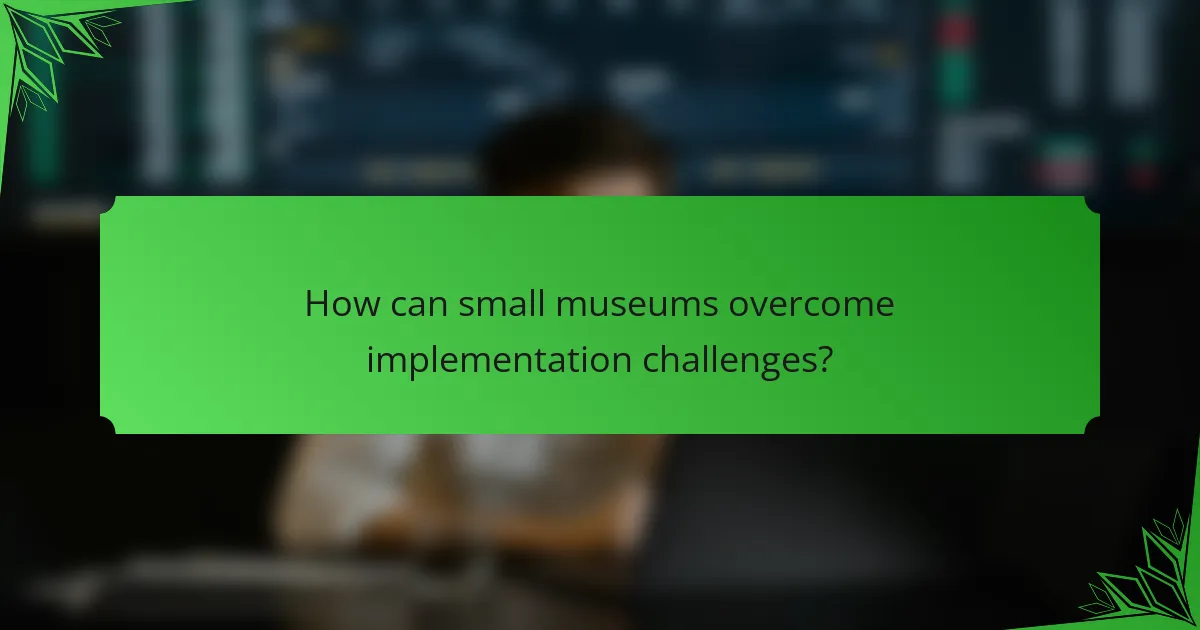
How can small museums overcome implementation challenges?
Small museums can overcome implementation challenges by leveraging partnerships, utilizing online resources, and engaging volunteers. These strategies help maximize limited resources and enhance operational efficiency.
Seek partnerships with larger institutions
Forming partnerships with larger museums or cultural institutions can provide small museums with access to resources, expertise, and funding opportunities. Collaborations can include shared exhibitions, joint programs, or mentorship arrangements.
Consider reaching out to local universities or art schools for potential partnerships. These institutions often have programs that encourage collaboration with smaller organizations, which can lead to mutual benefits.
Utilize online training resources
Online training resources can offer valuable guidance on best practices for implementing collections trust. Websites like the American Alliance of Museums and the International Council of Museums provide free or low-cost webinars and courses tailored to museum professionals.
Small museums should take advantage of these resources to stay updated on industry standards and improve their operational practices. Setting aside regular time for staff training can significantly enhance the museum’s capabilities.
Engage volunteers for support
Volunteers can play a crucial role in supporting small museums, especially in areas like collections management and visitor engagement. Recruiting local community members or students can help alleviate staffing shortages and bring fresh perspectives.
Establish a structured volunteer program that includes training and clear expectations. This approach not only benefits the museum but also fosters community involvement and ownership of the institution.

What are best practices for maintaining Collections Trust?
Best practices for maintaining Collections Trust in small museums include establishing clear policies, ensuring regular training for staff, and implementing effective documentation systems. These practices help safeguard collections and enhance accountability.
Establishing Clear Policies
Creating clear policies is essential for maintaining Collections Trust. These policies should outline the procedures for acquisition, care, and deaccessioning of items. Regularly reviewing and updating these policies ensures they remain relevant and effective.
Involve staff and stakeholders in the policy-making process to foster a sense of ownership and compliance. This collaborative approach can also help identify potential gaps in existing policies.
Regular Training for Staff
Training staff regularly on best practices for collections management is crucial. This includes educating them about the importance of Collections Trust, proper handling techniques, and ethical considerations. Training sessions can be conducted annually or semi-annually to keep everyone informed.
Consider using a mix of in-person workshops and online resources to accommodate different learning styles and schedules. Engaging staff in hands-on training can reinforce their understanding and commitment to the museum’s policies.
Implementing Effective Documentation Systems
An effective documentation system is vital for maintaining Collections Trust. This system should track the provenance, condition, and location of each item in the collection. Digital databases can streamline this process and improve accessibility for staff.
Ensure that documentation is updated regularly, especially after acquisitions or conservation efforts. Establishing a routine for audits can help identify discrepancies and maintain the integrity of the collection.
